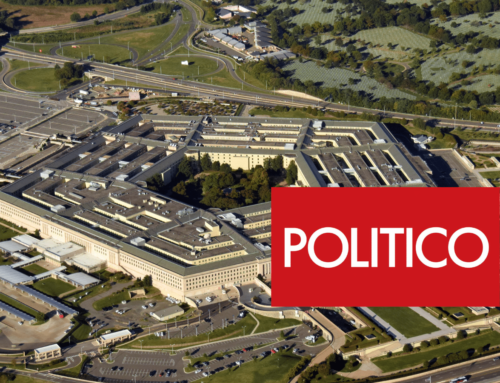The “New Cold War,” the “emerging Axis of Aggressors,” and “21st Century Peace Through Strength,” are just a few of the catch phrases Sen. Roger Wicker (R-MS), the Ranking Member on the Senate Armed Services Committee, has been bandying about to make his case for a massive $55 billion hike to the Pentagon budget. This increase would bring the total national security budget for the United States to $976 billion for Fiscal Year (FY) 2025, just shy of $1,000,000,000,000.
But lest we think $55 billion will slake his appetite, the senator has stated this hike is part of his plan to ramp up Pentagon spending to 5 percent of Gross Domestic Product (GDP) in the coming years. This is a dangerously bad idea for taxpayers and national security.
First, let’s tackle the absurdity of tying military spending to GDP. Proponents of this framework point out that military spending was 11 percent of GDP during the height of the Cold War and now rests at about 3 percent. This line of thinking presupposes that national security needs rise and fall with the state of the economy.
They don’t.
A booming economy does not increase the need for national security spending any more than a flailing economy lowers it. The champions of tying military spending to GDP know this, which is why you’ll never hear them calling for Pentagon spending cuts during a recession.
Eschewing this flawed logic, we can see that military spending has in fact grown significantly since the Cold War. After adjusting for inflation, Pentagon spending rose from $506 billion in 1980 to $820 billion in 2023—a 62 percent increase. National security spending should reflect national security needs, not GDP.
This brings us to the next pillar of Sen. Wicker’s case for a Pentagon budget spending spree—the Pentagon’s unfunded priorities. Sen. Wicker points to the Indo-Pacific Command’s unfunded priority list (UPL), a wish list of items not included in the president’s budget request, to justify his claim that the combatant command was “shortchanged a whopping $11 billion.” Interestingly, the senator’s plan includes only about $2 billion for items reflected in INDOPACOM’s list, so by his logic, his own plan still shortchanges the combatant command by $9 billion. Either way, we don’t agree.
The senator conveniently fails to mention that Congress requires the combatant commands to submit these extrabudgetary wish lists of items the Pentagon chose to exclude from its $850 billion budget request. This requirement fuels wasteful spending and circumvents both the normal budget process and the Pentagon’s civilian leadership—and as Sen. Wicker demonstrates, it serves as a convenient way to argue for increased spending without a holistic view of the overall budget context.
Another misconception showcased in Sen. Wicker’s plan is the notion that the military industrial base is woefully under-resourced, requiring a massive infusion of taxpayer dollars to keep our nation’s military manufacturing on track. This misdiagnoses the problem.
The industrial base has indeed faced recent challenges, from the war in Ukraine requiring greater munitions production to the submarine industrial base struggling to deliver new submarines on time. But the industry is more than capable of addressing these challenges without a bailout from taxpayers. In just the first quarter of 2024, five of the largest Pentagon contractors spent a combined $4.1 billion on stock buybacks, goosing their shareholder and CEO payouts when they could have been investing in the industrial capacity necessary to meet the Pentagon’s manufacturing demands. With this proper diagnosis, it’s evident that Sen. Wicker’s proposed increase for industrial base funding would reinforce the problem by rewarding the industry’s bad behavior rather than addressing it.
The most prominent aspect of Sen. Wicker’s argument is that we are in a New Cold War—locked into a new threat environment that demands ever greater military spending.
Clearly Russia has been aggressive, with the war in Ukraine being the prime example. It’s also true that China is expanding its military capabilities. Both of these realities are cause for concern—but not panic. The U.S. military remains the dominant fighting force on the planet, and we don’t need to spend another $55 billion this year to keep it that way. The war in Ukraine has demonstrated the Russian government’s expansionist agenda, but it’s also showcased the limits of its power. And unlike the U.S. and the Soviet Union during the Cold War, the U.S. and China are economically intertwined in ways that would make conflict incredibly costly for both nations, incentivizing both sides to avoid conflict and all its associated costs.
The only real beneficiaries of a $55 billion hike in Pentagon spending are Pentagon contractors paying for the privilege of Sen. Wicker’s support. As of this writing, Sen. Wicker—who would chair of the Armed Services Committee if the Senate flips after the next election—is the top Senate recipient of campaign contributions from the military industry, raking in $343,065 in the 2024 cycle so far.
Before they light the budget cap on fire, lawmakers should take a holistic look at the budget and recognize that we’ll soon be spending more on servicing our nation’s debt than on the military. Adding another $55 billion to the Pentagon budget will exacerbate this fiscal crisis, ultimately at the expense of national security.











Get Social